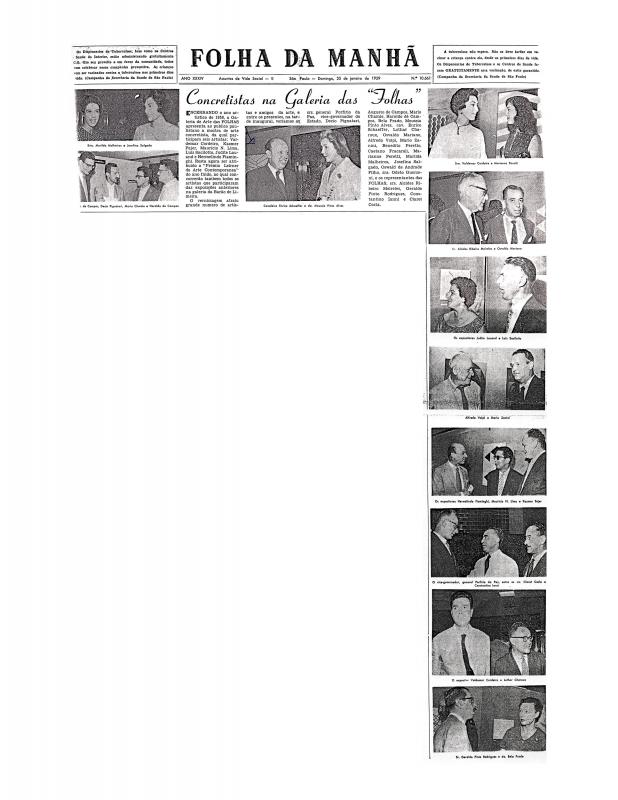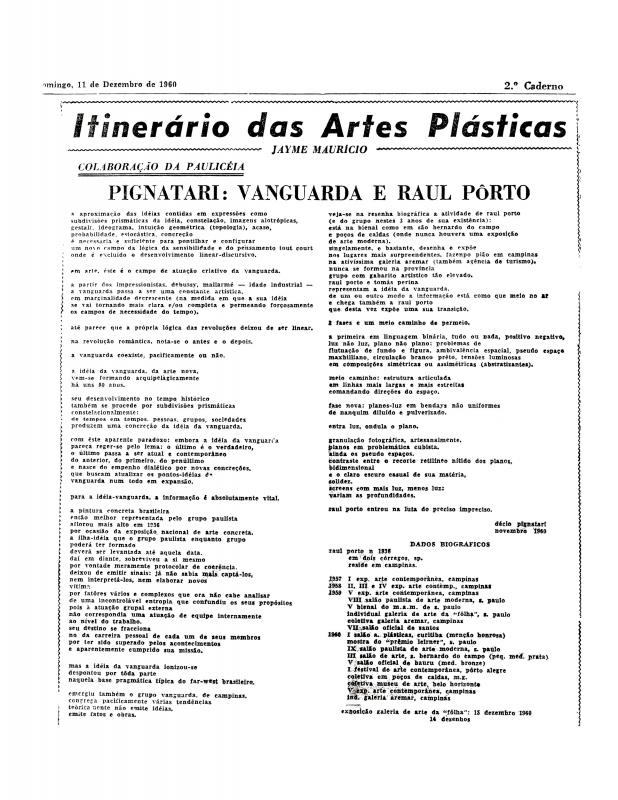In 1957, as preparations were under way for the fourth Bienal de São Paulo, the jury responsible for deciding who would represent Brazil at the event excluded the work of several artists. These artists, led by Flávio de Carvalho (1899−1973), and others in the local cultural milieu objected, claiming that the jury’s decision favored Concrete art and therefore ignored figurative art. Other prominent people agreed with and supported this view. One of the members of this latter group was the industrial magnate Isaí Leirner, the director at the time of the Museu de Arte Moderna de São Paulo. He therefore sponsored the 1958 exhibition 12 Artistas de São Paulo, which was originally conceived as an alternative to the biennial’s focus on Concrete art. This first exhibition—which was also known as the Prêmio Leirner (Leirner Prize)—was held in the lobby of the building that housed the offices of the newspaper Folha de São Paulo [see the ICAA digital archive (doc. no. 1232732)].
This exhibition provided opportunities and encouragement for artists who disagreed with the biennial’s preference, and Leirner eventually opened a gallery based on that concept, Galeria de Arte das Folhas. This gallery did more than host art exhibitions; it also organized debates and lectures that explored a wide range of trends and styles. Galeria de Arte das Folhas was established in 1958 by Isaí Leirner (1903–1962), one of the directors of the Museu de Arte Moderna de São Paulo, with the assistance of the Grupo Folha that, among other things, published the newspaper Folha de São Paulo. The idea for the creation of the gallery arose out of a disagreement that flared up during the fourth Bienal de São Paulo held in 1957. Flávio de Carvalho (1899–1973), an eccentric poète maudit and controversial artist during the 1930s who had been excluded from the biennial, accused the organizing committee of prejudice, claiming that it had shown favoritism toward Concrete art, thus dismissing any kind of figurative art. As a result of this incident, Isaí Leirner organized the exhibition 12 Artistas de São Paulo in the lobby of the newspaper’s offices in the Alameda Barão de Limeira—which was adjacent to the public thoroughfare in the historic Campos Elísios neighborhood. It was a space devoted to the visual arts that was in clear violation of the biennial’s rules. Ironically, the exhibition referred to in the article—which was organized a year after the gallery opened—was all about Concrete art. In other words, another disaster for Carvalho. The gallery was open from 1958 to 1962, the year when Isaí Leirner, the exhibition space’s main champion, passed away.
The leaflet produced for the Prêmio Leirner de Arte Contemporânea (Leirner Prize for Contemporary Art) in 1960 included a brief biography of each of the prizewinning artists: Thomaz Perina (1921−2009), Murilo Penteado (born 1928), Nobe Xandó (1915−2010), Raúl Porto (1936−99), and Moacyr Rocha. It also included critiques by important artists such as Waldemar Cordeiro (1925−1973), Oswaldo de Andrade filho (1914−1972), Wolfgang Pfeiffer, and Décio Pignatari (1927−2012), and texts that explained the importance of each prizewinner and how the exhibited works were related to and could be compared with other art events.
One of those chosen for the Prêmio Leirner in 1960 was Raúl Porto, who showed an early interest in painting and graphic design. His work was included in the first Exposição de arte contemporânea de Campinas in 1957. A year later he joined the Grupo Vanguarda and became the group’s “spokesman.” In time, Porto achieved a certain measure of fame. He took part in the fifth, seventh, eighth, and ninth editions of the Bienal de São Paulo. (Regarding Pignatari’s critique of Porto, see doc. 1233071.)


